Business Report: Forces Shaping Electric Vehicle Industry in Europe
VerifiedAdded on 2021/02/20
|12
|3260
|109
Report
AI Summary
This report provides an in-depth analysis of the electric vehicle (EV) market in Europe, focusing on the forces reshaping the automotive industry. It examines the political, economic, social, technological, environmental, and legal factors driving the shift towards EVs. The report details the changes implemented by automotive companies, such as Volvo, in response to the emerging EV market, including business goals, technological advancements, operational adjustments, workforce management, and supply chain modifications. Furthermore, it assesses future changes required for companies to remain competitive, particularly in fuel cell technology and marketing strategies. A Porter's Five Forces analysis evaluates supplier power, buyer power, barriers to entry, and the threat of substitutes within the European EV market. The report highlights the current business environment, opportunities, and challenges, offering a comprehensive overview of the evolving landscape of electric vehicles in Europe.
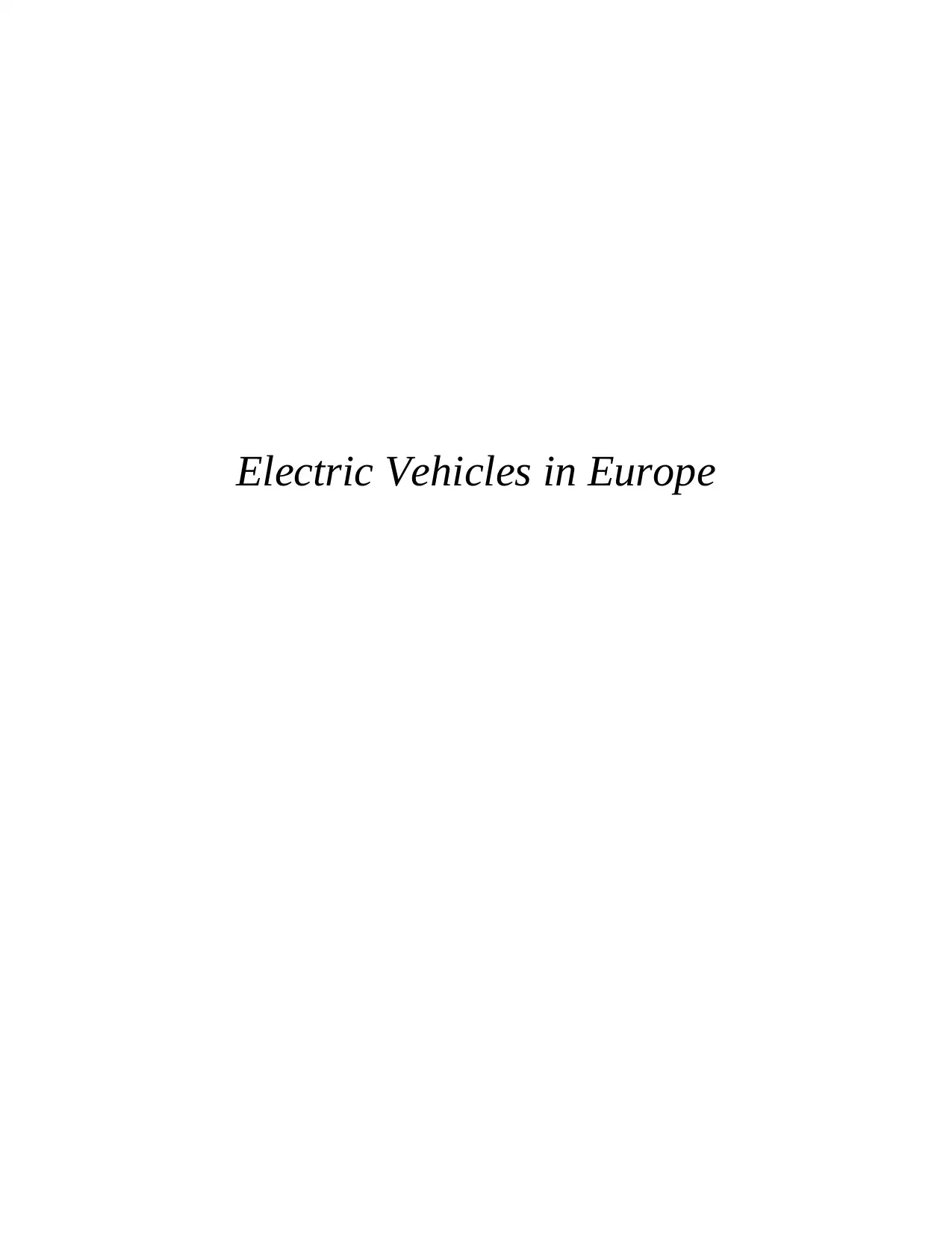
Electric Vehicles in Europe
Paraphrase This Document
Need a fresh take? Get an instant paraphrase of this document with our AI Paraphraser
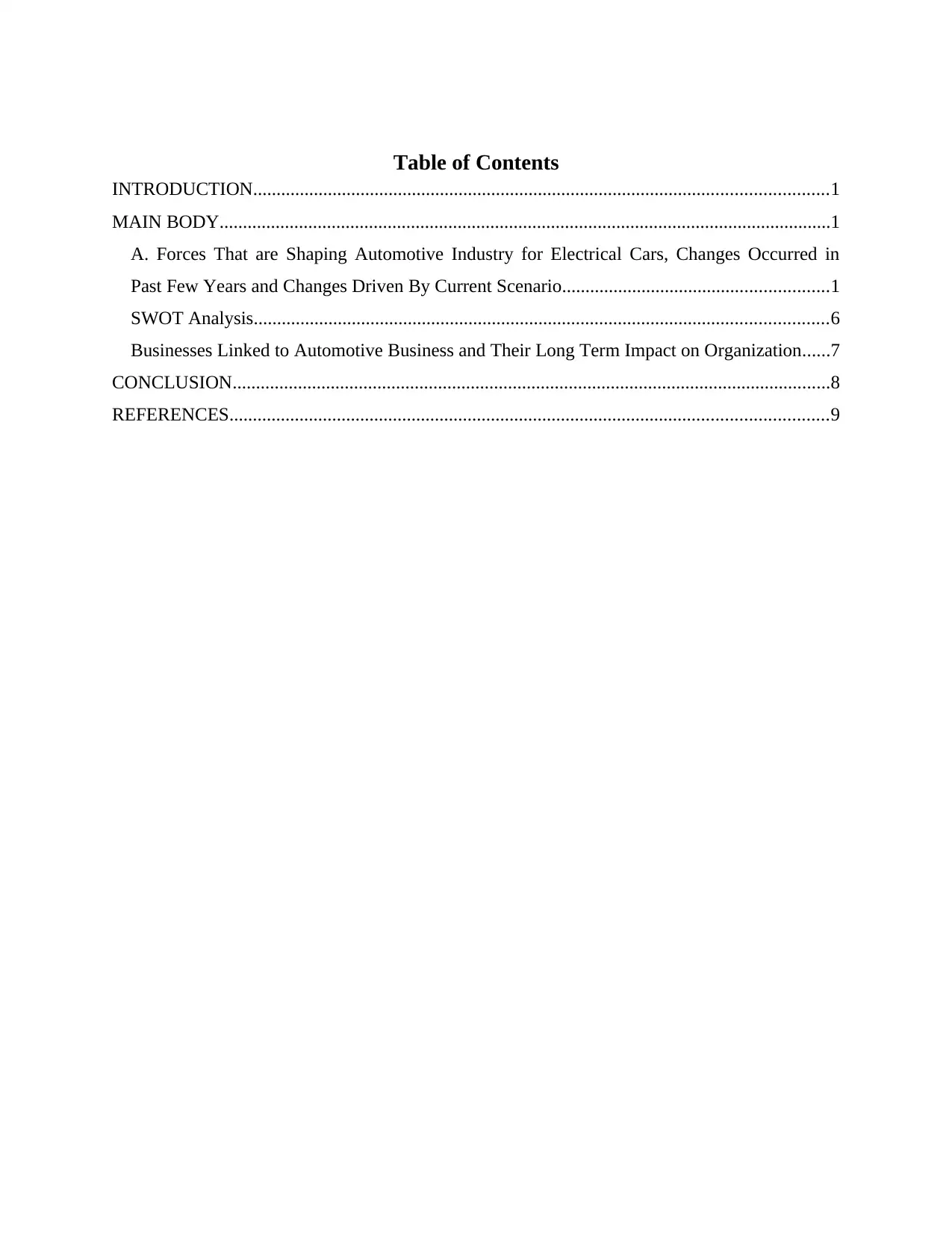
Table of Contents
INTRODUCTION...........................................................................................................................1
MAIN BODY...................................................................................................................................1
A. Forces That are Shaping Automotive Industry for Electrical Cars, Changes Occurred in
Past Few Years and Changes Driven By Current Scenario.........................................................1
SWOT Analysis...........................................................................................................................6
Businesses Linked to Automotive Business and Their Long Term Impact on Organization......7
CONCLUSION................................................................................................................................8
REFERENCES................................................................................................................................9
INTRODUCTION...........................................................................................................................1
MAIN BODY...................................................................................................................................1
A. Forces That are Shaping Automotive Industry for Electrical Cars, Changes Occurred in
Past Few Years and Changes Driven By Current Scenario.........................................................1
SWOT Analysis...........................................................................................................................6
Businesses Linked to Automotive Business and Their Long Term Impact on Organization......7
CONCLUSION................................................................................................................................8
REFERENCES................................................................................................................................9
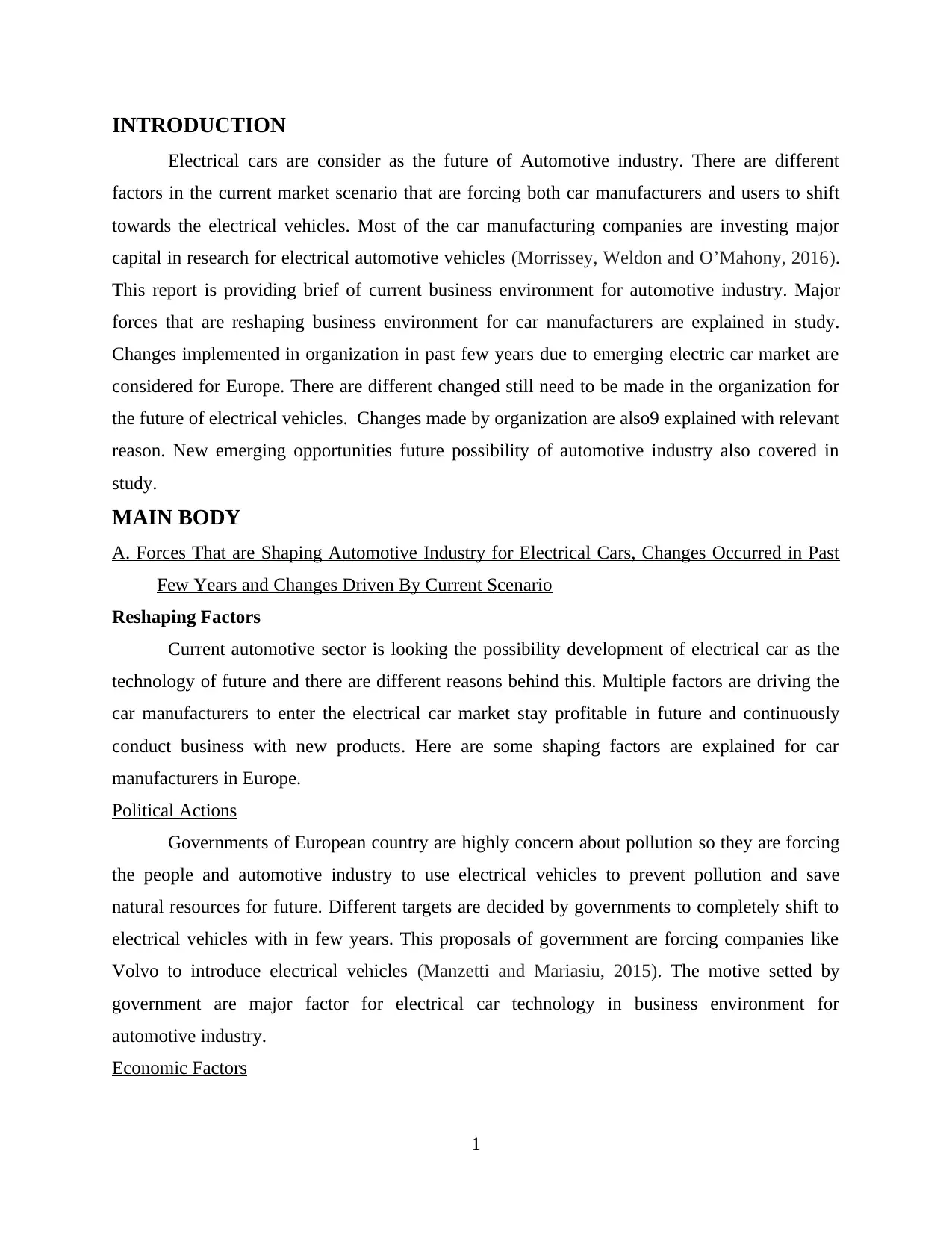
INTRODUCTION
Electrical cars are consider as the future of Automotive industry. There are different
factors in the current market scenario that are forcing both car manufacturers and users to shift
towards the electrical vehicles. Most of the car manufacturing companies are investing major
capital in research for electrical automotive vehicles (Morrissey, Weldon and O’Mahony, 2016).
This report is providing brief of current business environment for automotive industry. Major
forces that are reshaping business environment for car manufacturers are explained in study.
Changes implemented in organization in past few years due to emerging electric car market are
considered for Europe. There are different changed still need to be made in the organization for
the future of electrical vehicles. Changes made by organization are also9 explained with relevant
reason. New emerging opportunities future possibility of automotive industry also covered in
study.
MAIN BODY
A. Forces That are Shaping Automotive Industry for Electrical Cars, Changes Occurred in Past
Few Years and Changes Driven By Current Scenario
Reshaping Factors
Current automotive sector is looking the possibility development of electrical car as the
technology of future and there are different reasons behind this. Multiple factors are driving the
car manufacturers to enter the electrical car market stay profitable in future and continuously
conduct business with new products. Here are some shaping factors are explained for car
manufacturers in Europe.
Political Actions
Governments of European country are highly concern about pollution so they are forcing
the people and automotive industry to use electrical vehicles to prevent pollution and save
natural resources for future. Different targets are decided by governments to completely shift to
electrical vehicles with in few years. This proposals of government are forcing companies like
Volvo to introduce electrical vehicles (Manzetti and Mariasiu, 2015). The motive setted by
government are major factor for electrical car technology in business environment for
automotive industry.
Economic Factors
1
Electrical cars are consider as the future of Automotive industry. There are different
factors in the current market scenario that are forcing both car manufacturers and users to shift
towards the electrical vehicles. Most of the car manufacturing companies are investing major
capital in research for electrical automotive vehicles (Morrissey, Weldon and O’Mahony, 2016).
This report is providing brief of current business environment for automotive industry. Major
forces that are reshaping business environment for car manufacturers are explained in study.
Changes implemented in organization in past few years due to emerging electric car market are
considered for Europe. There are different changed still need to be made in the organization for
the future of electrical vehicles. Changes made by organization are also9 explained with relevant
reason. New emerging opportunities future possibility of automotive industry also covered in
study.
MAIN BODY
A. Forces That are Shaping Automotive Industry for Electrical Cars, Changes Occurred in Past
Few Years and Changes Driven By Current Scenario
Reshaping Factors
Current automotive sector is looking the possibility development of electrical car as the
technology of future and there are different reasons behind this. Multiple factors are driving the
car manufacturers to enter the electrical car market stay profitable in future and continuously
conduct business with new products. Here are some shaping factors are explained for car
manufacturers in Europe.
Political Actions
Governments of European country are highly concern about pollution so they are forcing
the people and automotive industry to use electrical vehicles to prevent pollution and save
natural resources for future. Different targets are decided by governments to completely shift to
electrical vehicles with in few years. This proposals of government are forcing companies like
Volvo to introduce electrical vehicles (Manzetti and Mariasiu, 2015). The motive setted by
government are major factor for electrical car technology in business environment for
automotive industry.
Economic Factors
1
⊘ This is a preview!⊘
Do you want full access?
Subscribe today to unlock all pages.

Trusted by 1+ million students worldwide
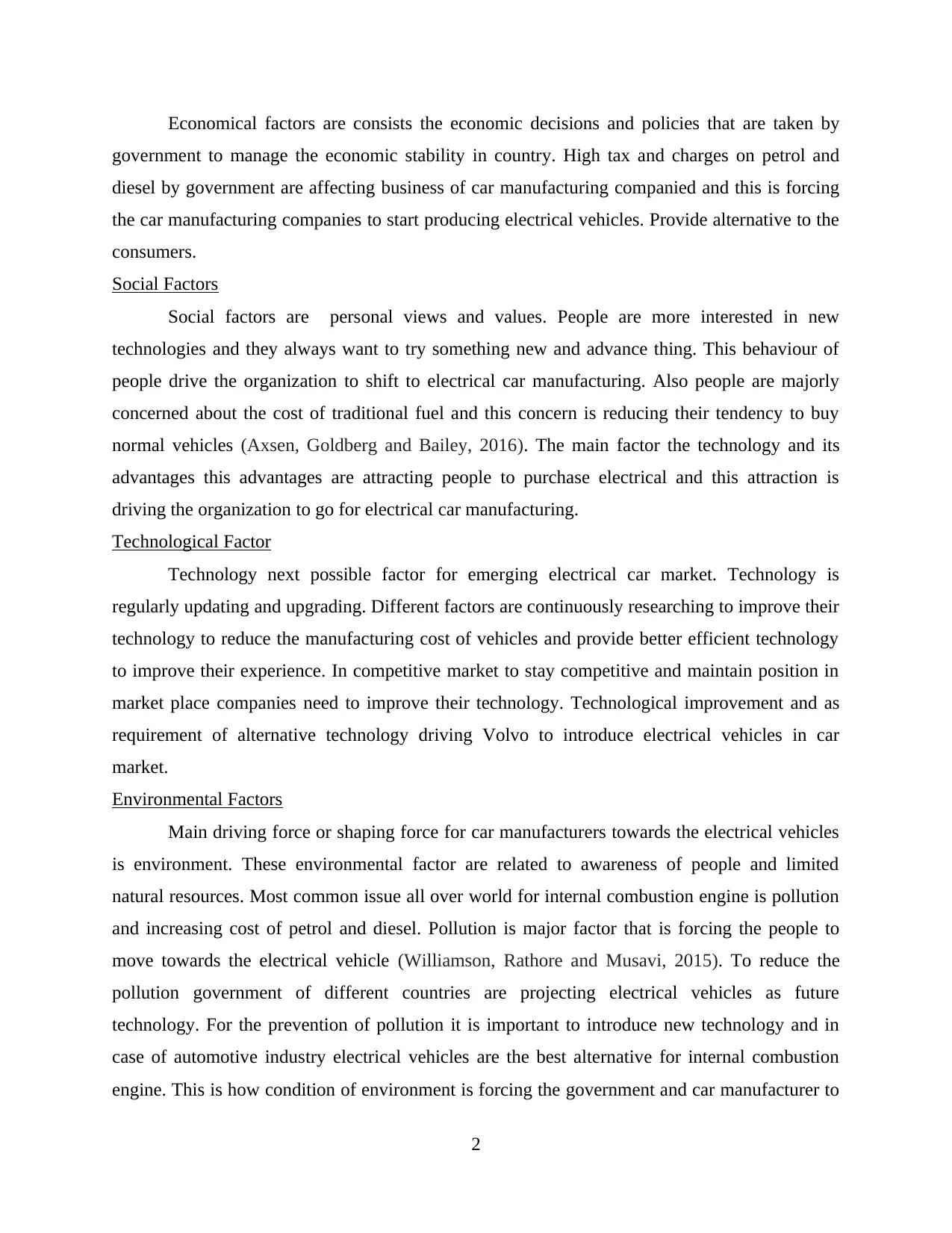
Economical factors are consists the economic decisions and policies that are taken by
government to manage the economic stability in country. High tax and charges on petrol and
diesel by government are affecting business of car manufacturing companied and this is forcing
the car manufacturing companies to start producing electrical vehicles. Provide alternative to the
consumers.
Social Factors
Social factors are personal views and values. People are more interested in new
technologies and they always want to try something new and advance thing. This behaviour of
people drive the organization to shift to electrical car manufacturing. Also people are majorly
concerned about the cost of traditional fuel and this concern is reducing their tendency to buy
normal vehicles (Axsen, Goldberg and Bailey, 2016). The main factor the technology and its
advantages this advantages are attracting people to purchase electrical and this attraction is
driving the organization to go for electrical car manufacturing.
Technological Factor
Technology next possible factor for emerging electrical car market. Technology is
regularly updating and upgrading. Different factors are continuously researching to improve their
technology to reduce the manufacturing cost of vehicles and provide better efficient technology
to improve their experience. In competitive market to stay competitive and maintain position in
market place companies need to improve their technology. Technological improvement and as
requirement of alternative technology driving Volvo to introduce electrical vehicles in car
market.
Environmental Factors
Main driving force or shaping force for car manufacturers towards the electrical vehicles
is environment. These environmental factor are related to awareness of people and limited
natural resources. Most common issue all over world for internal combustion engine is pollution
and increasing cost of petrol and diesel. Pollution is major factor that is forcing the people to
move towards the electrical vehicle (Williamson, Rathore and Musavi, 2015). To reduce the
pollution government of different countries are projecting electrical vehicles as future
technology. For the prevention of pollution it is important to introduce new technology and in
case of automotive industry electrical vehicles are the best alternative for internal combustion
engine. This is how condition of environment is forcing the government and car manufacturer to
2
government to manage the economic stability in country. High tax and charges on petrol and
diesel by government are affecting business of car manufacturing companied and this is forcing
the car manufacturing companies to start producing electrical vehicles. Provide alternative to the
consumers.
Social Factors
Social factors are personal views and values. People are more interested in new
technologies and they always want to try something new and advance thing. This behaviour of
people drive the organization to shift to electrical car manufacturing. Also people are majorly
concerned about the cost of traditional fuel and this concern is reducing their tendency to buy
normal vehicles (Axsen, Goldberg and Bailey, 2016). The main factor the technology and its
advantages this advantages are attracting people to purchase electrical and this attraction is
driving the organization to go for electrical car manufacturing.
Technological Factor
Technology next possible factor for emerging electrical car market. Technology is
regularly updating and upgrading. Different factors are continuously researching to improve their
technology to reduce the manufacturing cost of vehicles and provide better efficient technology
to improve their experience. In competitive market to stay competitive and maintain position in
market place companies need to improve their technology. Technological improvement and as
requirement of alternative technology driving Volvo to introduce electrical vehicles in car
market.
Environmental Factors
Main driving force or shaping force for car manufacturers towards the electrical vehicles
is environment. These environmental factor are related to awareness of people and limited
natural resources. Most common issue all over world for internal combustion engine is pollution
and increasing cost of petrol and diesel. Pollution is major factor that is forcing the people to
move towards the electrical vehicle (Williamson, Rathore and Musavi, 2015). To reduce the
pollution government of different countries are projecting electrical vehicles as future
technology. For the prevention of pollution it is important to introduce new technology and in
case of automotive industry electrical vehicles are the best alternative for internal combustion
engine. This is how condition of environment is forcing the government and car manufacturer to
2
Paraphrase This Document
Need a fresh take? Get an instant paraphrase of this document with our AI Paraphraser
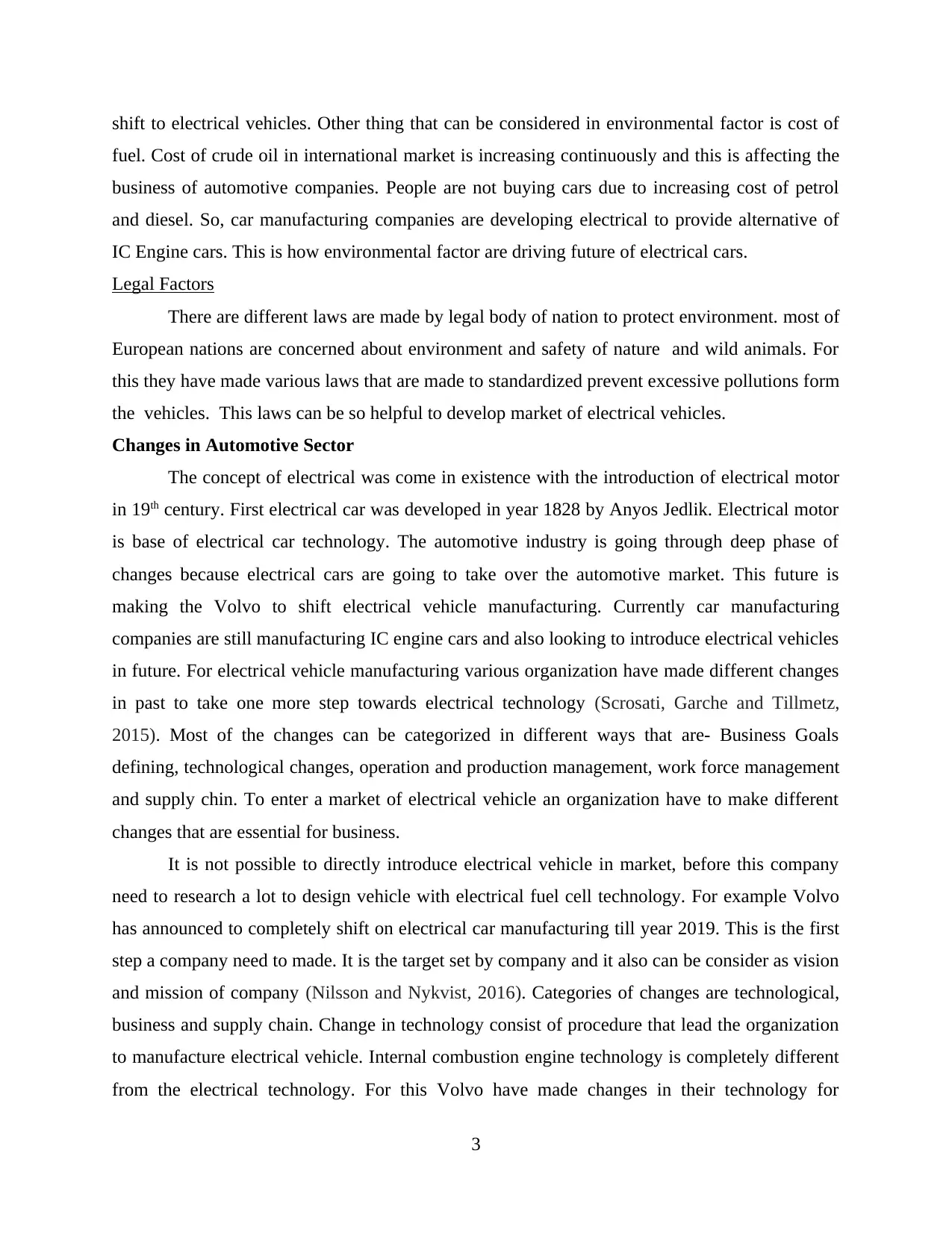
shift to electrical vehicles. Other thing that can be considered in environmental factor is cost of
fuel. Cost of crude oil in international market is increasing continuously and this is affecting the
business of automotive companies. People are not buying cars due to increasing cost of petrol
and diesel. So, car manufacturing companies are developing electrical to provide alternative of
IC Engine cars. This is how environmental factor are driving future of electrical cars.
Legal Factors
There are different laws are made by legal body of nation to protect environment. most of
European nations are concerned about environment and safety of nature and wild animals. For
this they have made various laws that are made to standardized prevent excessive pollutions form
the vehicles. This laws can be so helpful to develop market of electrical vehicles.
Changes in Automotive Sector
The concept of electrical was come in existence with the introduction of electrical motor
in 19th century. First electrical car was developed in year 1828 by Anyos Jedlik. Electrical motor
is base of electrical car technology. The automotive industry is going through deep phase of
changes because electrical cars are going to take over the automotive market. This future is
making the Volvo to shift electrical vehicle manufacturing. Currently car manufacturing
companies are still manufacturing IC engine cars and also looking to introduce electrical vehicles
in future. For electrical vehicle manufacturing various organization have made different changes
in past to take one more step towards electrical technology (Scrosati, Garche and Tillmetz,
2015). Most of the changes can be categorized in different ways that are- Business Goals
defining, technological changes, operation and production management, work force management
and supply chin. To enter a market of electrical vehicle an organization have to make different
changes that are essential for business.
It is not possible to directly introduce electrical vehicle in market, before this company
need to research a lot to design vehicle with electrical fuel cell technology. For example Volvo
has announced to completely shift on electrical car manufacturing till year 2019. This is the first
step a company need to made. It is the target set by company and it also can be consider as vision
and mission of company (Nilsson and Nykvist, 2016). Categories of changes are technological,
business and supply chain. Change in technology consist of procedure that lead the organization
to manufacture electrical vehicle. Internal combustion engine technology is completely different
from the electrical technology. For this Volvo have made changes in their technology for
3
fuel. Cost of crude oil in international market is increasing continuously and this is affecting the
business of automotive companies. People are not buying cars due to increasing cost of petrol
and diesel. So, car manufacturing companies are developing electrical to provide alternative of
IC Engine cars. This is how environmental factor are driving future of electrical cars.
Legal Factors
There are different laws are made by legal body of nation to protect environment. most of
European nations are concerned about environment and safety of nature and wild animals. For
this they have made various laws that are made to standardized prevent excessive pollutions form
the vehicles. This laws can be so helpful to develop market of electrical vehicles.
Changes in Automotive Sector
The concept of electrical was come in existence with the introduction of electrical motor
in 19th century. First electrical car was developed in year 1828 by Anyos Jedlik. Electrical motor
is base of electrical car technology. The automotive industry is going through deep phase of
changes because electrical cars are going to take over the automotive market. This future is
making the Volvo to shift electrical vehicle manufacturing. Currently car manufacturing
companies are still manufacturing IC engine cars and also looking to introduce electrical vehicles
in future. For electrical vehicle manufacturing various organization have made different changes
in past to take one more step towards electrical technology (Scrosati, Garche and Tillmetz,
2015). Most of the changes can be categorized in different ways that are- Business Goals
defining, technological changes, operation and production management, work force management
and supply chin. To enter a market of electrical vehicle an organization have to make different
changes that are essential for business.
It is not possible to directly introduce electrical vehicle in market, before this company
need to research a lot to design vehicle with electrical fuel cell technology. For example Volvo
has announced to completely shift on electrical car manufacturing till year 2019. This is the first
step a company need to made. It is the target set by company and it also can be consider as vision
and mission of company (Nilsson and Nykvist, 2016). Categories of changes are technological,
business and supply chain. Change in technology consist of procedure that lead the organization
to manufacture electrical vehicle. Internal combustion engine technology is completely different
from the electrical technology. For this Volvo have made changes in their technology for
3
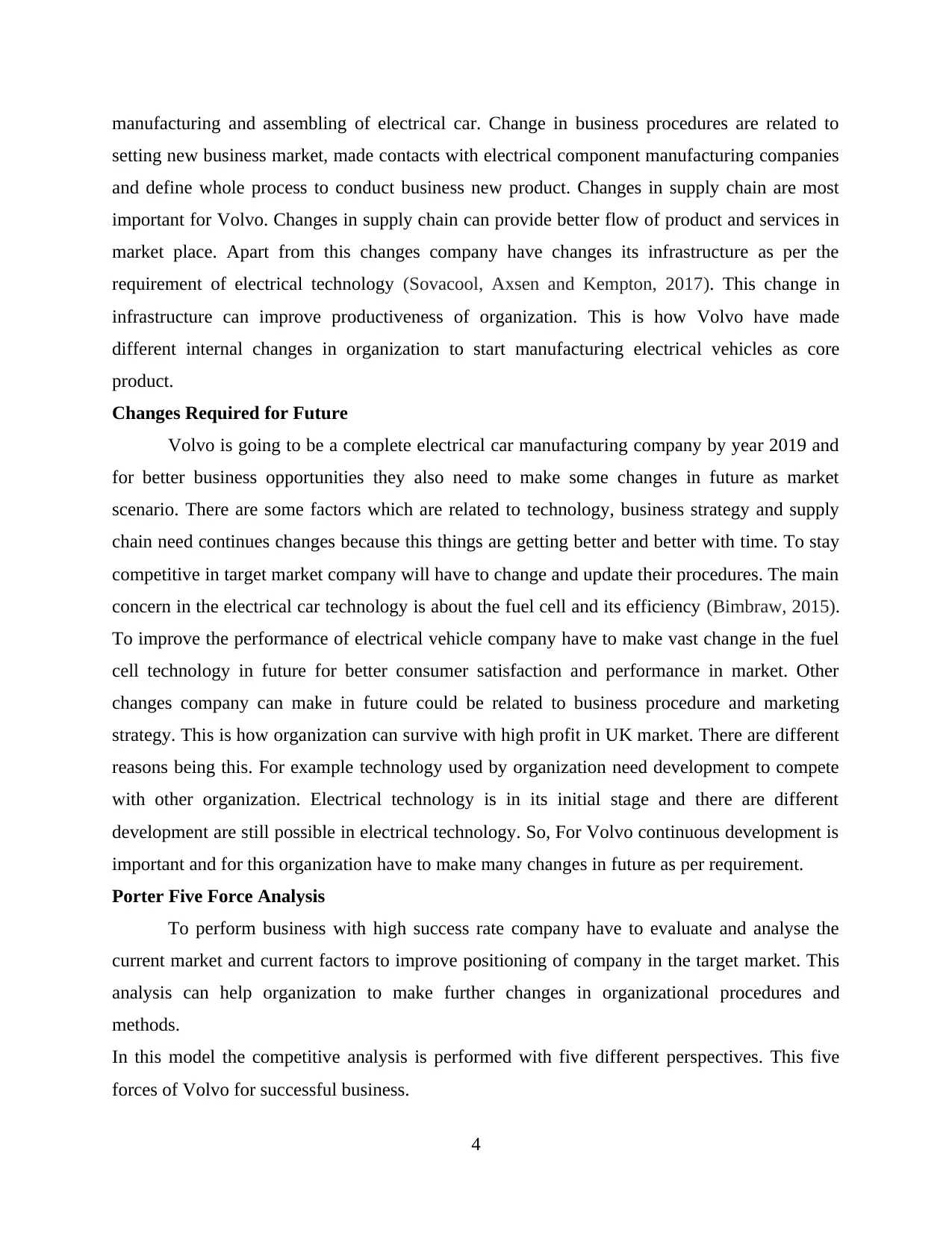
manufacturing and assembling of electrical car. Change in business procedures are related to
setting new business market, made contacts with electrical component manufacturing companies
and define whole process to conduct business new product. Changes in supply chain are most
important for Volvo. Changes in supply chain can provide better flow of product and services in
market place. Apart from this changes company have changes its infrastructure as per the
requirement of electrical technology (Sovacool, Axsen and Kempton, 2017). This change in
infrastructure can improve productiveness of organization. This is how Volvo have made
different internal changes in organization to start manufacturing electrical vehicles as core
product.
Changes Required for Future
Volvo is going to be a complete electrical car manufacturing company by year 2019 and
for better business opportunities they also need to make some changes in future as market
scenario. There are some factors which are related to technology, business strategy and supply
chain need continues changes because this things are getting better and better with time. To stay
competitive in target market company will have to change and update their procedures. The main
concern in the electrical car technology is about the fuel cell and its efficiency (Bimbraw, 2015).
To improve the performance of electrical vehicle company have to make vast change in the fuel
cell technology in future for better consumer satisfaction and performance in market. Other
changes company can make in future could be related to business procedure and marketing
strategy. This is how organization can survive with high profit in UK market. There are different
reasons being this. For example technology used by organization need development to compete
with other organization. Electrical technology is in its initial stage and there are different
development are still possible in electrical technology. So, For Volvo continuous development is
important and for this organization have to make many changes in future as per requirement.
Porter Five Force Analysis
To perform business with high success rate company have to evaluate and analyse the
current market and current factors to improve positioning of company in the target market. This
analysis can help organization to make further changes in organizational procedures and
methods.
In this model the competitive analysis is performed with five different perspectives. This five
forces of Volvo for successful business.
4
setting new business market, made contacts with electrical component manufacturing companies
and define whole process to conduct business new product. Changes in supply chain are most
important for Volvo. Changes in supply chain can provide better flow of product and services in
market place. Apart from this changes company have changes its infrastructure as per the
requirement of electrical technology (Sovacool, Axsen and Kempton, 2017). This change in
infrastructure can improve productiveness of organization. This is how Volvo have made
different internal changes in organization to start manufacturing electrical vehicles as core
product.
Changes Required for Future
Volvo is going to be a complete electrical car manufacturing company by year 2019 and
for better business opportunities they also need to make some changes in future as market
scenario. There are some factors which are related to technology, business strategy and supply
chain need continues changes because this things are getting better and better with time. To stay
competitive in target market company will have to change and update their procedures. The main
concern in the electrical car technology is about the fuel cell and its efficiency (Bimbraw, 2015).
To improve the performance of electrical vehicle company have to make vast change in the fuel
cell technology in future for better consumer satisfaction and performance in market. Other
changes company can make in future could be related to business procedure and marketing
strategy. This is how organization can survive with high profit in UK market. There are different
reasons being this. For example technology used by organization need development to compete
with other organization. Electrical technology is in its initial stage and there are different
development are still possible in electrical technology. So, For Volvo continuous development is
important and for this organization have to make many changes in future as per requirement.
Porter Five Force Analysis
To perform business with high success rate company have to evaluate and analyse the
current market and current factors to improve positioning of company in the target market. This
analysis can help organization to make further changes in organizational procedures and
methods.
In this model the competitive analysis is performed with five different perspectives. This five
forces of Volvo for successful business.
4
⊘ This is a preview!⊘
Do you want full access?
Subscribe today to unlock all pages.

Trusted by 1+ million students worldwide
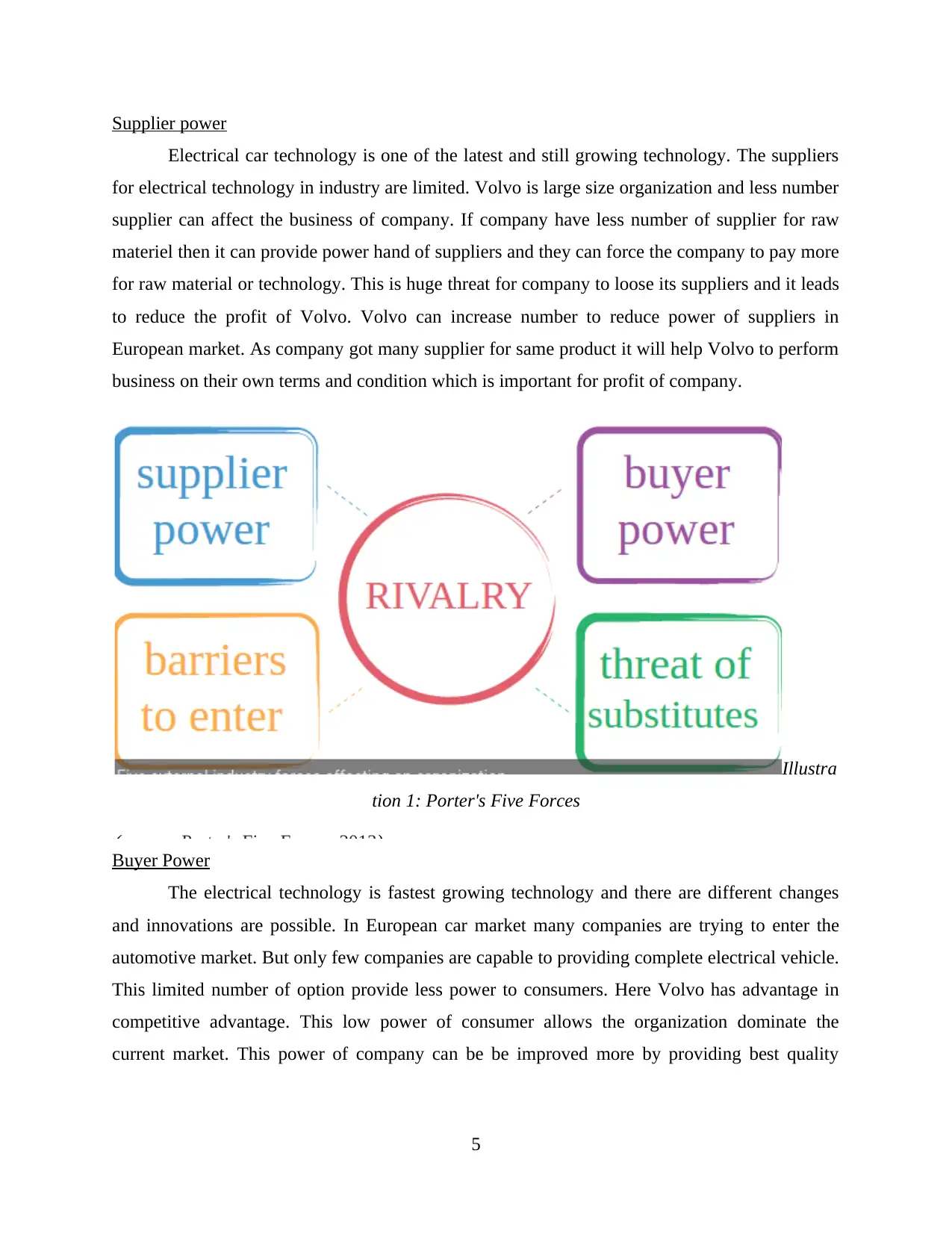
Supplier power
Electrical car technology is one of the latest and still growing technology. The suppliers
for electrical technology in industry are limited. Volvo is large size organization and less number
supplier can affect the business of company. If company have less number of supplier for raw
materiel then it can provide power hand of suppliers and they can force the company to pay more
for raw material or technology. This is huge threat for company to loose its suppliers and it leads
to reduce the profit of Volvo. Volvo can increase number to reduce power of suppliers in
European market. As company got many supplier for same product it will help Volvo to perform
business on their own terms and condition which is important for profit of company.
Buyer Power
The electrical technology is fastest growing technology and there are different changes
and innovations are possible. In European car market many companies are trying to enter the
automotive market. But only few companies are capable to providing complete electrical vehicle.
This limited number of option provide less power to consumers. Here Volvo has advantage in
competitive advantage. This low power of consumer allows the organization dominate the
current market. This power of company can be be improved more by providing best quality
5
Illustra
tion 1: Porter's Five Forces
(source: Porter's Five Forces. 2013)
Electrical car technology is one of the latest and still growing technology. The suppliers
for electrical technology in industry are limited. Volvo is large size organization and less number
supplier can affect the business of company. If company have less number of supplier for raw
materiel then it can provide power hand of suppliers and they can force the company to pay more
for raw material or technology. This is huge threat for company to loose its suppliers and it leads
to reduce the profit of Volvo. Volvo can increase number to reduce power of suppliers in
European market. As company got many supplier for same product it will help Volvo to perform
business on their own terms and condition which is important for profit of company.
Buyer Power
The electrical technology is fastest growing technology and there are different changes
and innovations are possible. In European car market many companies are trying to enter the
automotive market. But only few companies are capable to providing complete electrical vehicle.
This limited number of option provide less power to consumers. Here Volvo has advantage in
competitive advantage. This low power of consumer allows the organization dominate the
current market. This power of company can be be improved more by providing best quality
5
Illustra
tion 1: Porter's Five Forces
(source: Porter's Five Forces. 2013)
Paraphrase This Document
Need a fresh take? Get an instant paraphrase of this document with our AI Paraphraser
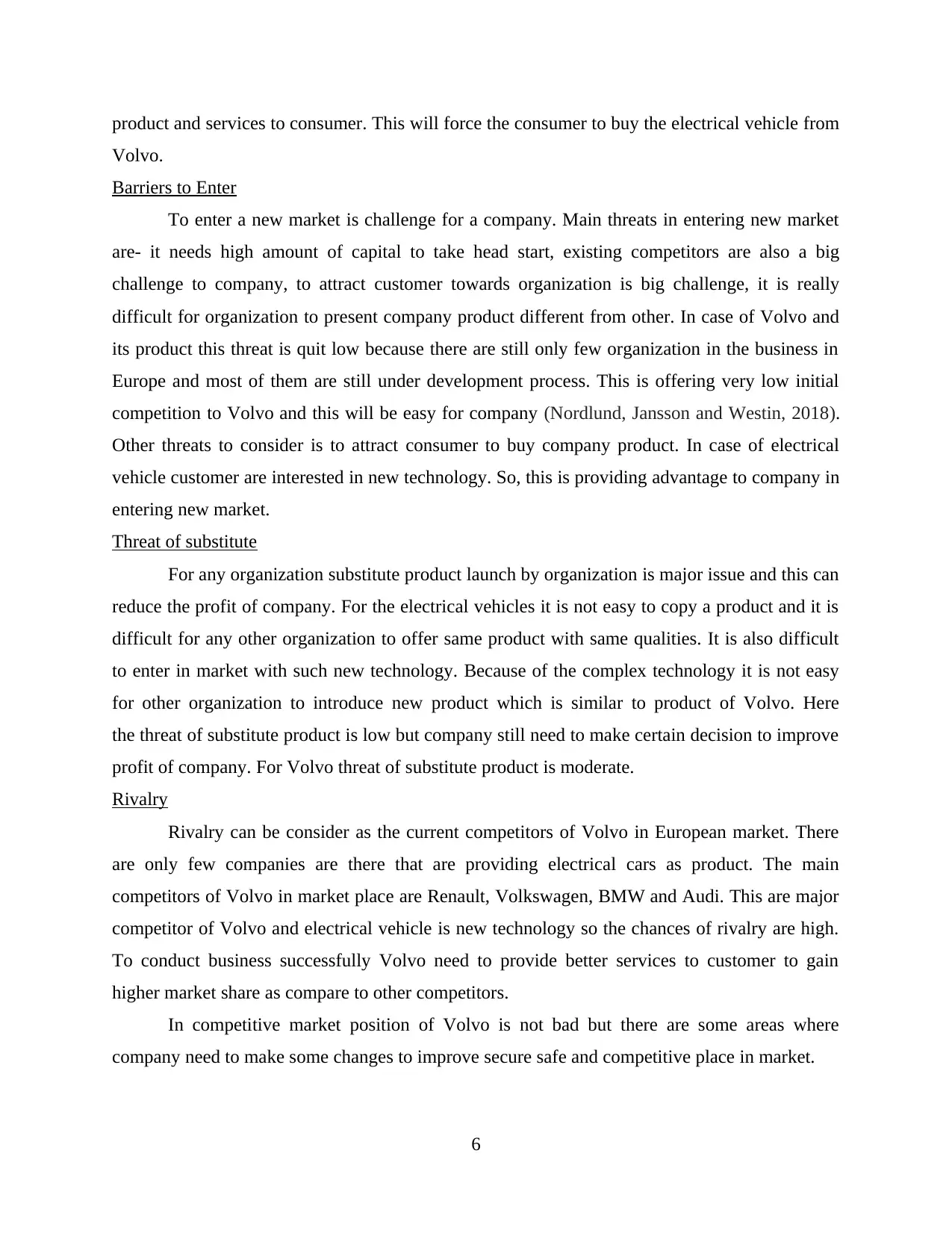
product and services to consumer. This will force the consumer to buy the electrical vehicle from
Volvo.
Barriers to Enter
To enter a new market is challenge for a company. Main threats in entering new market
are- it needs high amount of capital to take head start, existing competitors are also a big
challenge to company, to attract customer towards organization is big challenge, it is really
difficult for organization to present company product different from other. In case of Volvo and
its product this threat is quit low because there are still only few organization in the business in
Europe and most of them are still under development process. This is offering very low initial
competition to Volvo and this will be easy for company (Nordlund, Jansson and Westin, 2018).
Other threats to consider is to attract consumer to buy company product. In case of electrical
vehicle customer are interested in new technology. So, this is providing advantage to company in
entering new market.
Threat of substitute
For any organization substitute product launch by organization is major issue and this can
reduce the profit of company. For the electrical vehicles it is not easy to copy a product and it is
difficult for any other organization to offer same product with same qualities. It is also difficult
to enter in market with such new technology. Because of the complex technology it is not easy
for other organization to introduce new product which is similar to product of Volvo. Here
the threat of substitute product is low but company still need to make certain decision to improve
profit of company. For Volvo threat of substitute product is moderate.
Rivalry
Rivalry can be consider as the current competitors of Volvo in European market. There
are only few companies are there that are providing electrical cars as product. The main
competitors of Volvo in market place are Renault, Volkswagen, BMW and Audi. This are major
competitor of Volvo and electrical vehicle is new technology so the chances of rivalry are high.
To conduct business successfully Volvo need to provide better services to customer to gain
higher market share as compare to other competitors.
In competitive market position of Volvo is not bad but there are some areas where
company need to make some changes to improve secure safe and competitive place in market.
6
Volvo.
Barriers to Enter
To enter a new market is challenge for a company. Main threats in entering new market
are- it needs high amount of capital to take head start, existing competitors are also a big
challenge to company, to attract customer towards organization is big challenge, it is really
difficult for organization to present company product different from other. In case of Volvo and
its product this threat is quit low because there are still only few organization in the business in
Europe and most of them are still under development process. This is offering very low initial
competition to Volvo and this will be easy for company (Nordlund, Jansson and Westin, 2018).
Other threats to consider is to attract consumer to buy company product. In case of electrical
vehicle customer are interested in new technology. So, this is providing advantage to company in
entering new market.
Threat of substitute
For any organization substitute product launch by organization is major issue and this can
reduce the profit of company. For the electrical vehicles it is not easy to copy a product and it is
difficult for any other organization to offer same product with same qualities. It is also difficult
to enter in market with such new technology. Because of the complex technology it is not easy
for other organization to introduce new product which is similar to product of Volvo. Here
the threat of substitute product is low but company still need to make certain decision to improve
profit of company. For Volvo threat of substitute product is moderate.
Rivalry
Rivalry can be consider as the current competitors of Volvo in European market. There
are only few companies are there that are providing electrical cars as product. The main
competitors of Volvo in market place are Renault, Volkswagen, BMW and Audi. This are major
competitor of Volvo and electrical vehicle is new technology so the chances of rivalry are high.
To conduct business successfully Volvo need to provide better services to customer to gain
higher market share as compare to other competitors.
In competitive market position of Volvo is not bad but there are some areas where
company need to make some changes to improve secure safe and competitive place in market.
6
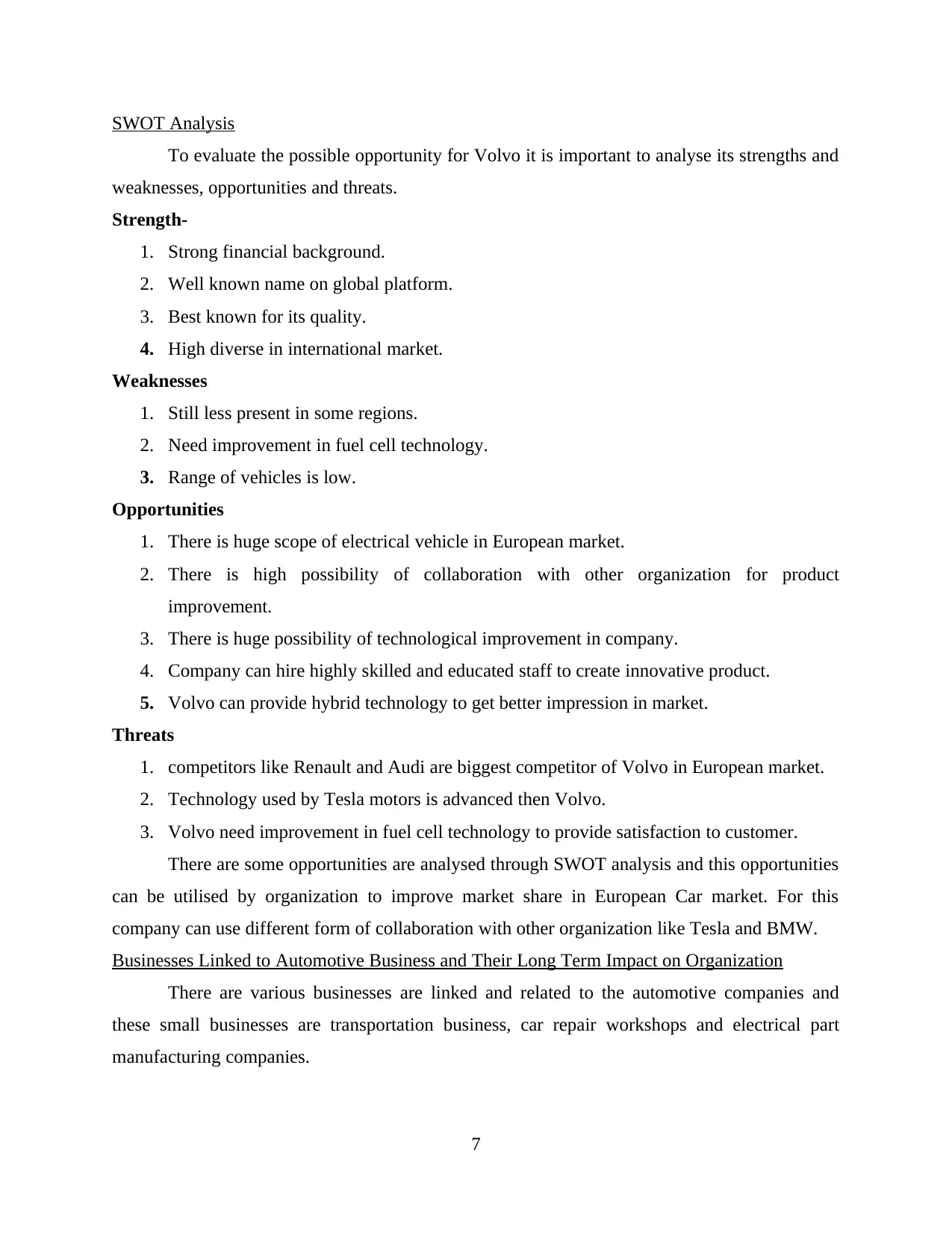
SWOT Analysis
To evaluate the possible opportunity for Volvo it is important to analyse its strengths and
weaknesses, opportunities and threats.
Strength-
1. Strong financial background.
2. Well known name on global platform.
3. Best known for its quality.
4. High diverse in international market.
Weaknesses
1. Still less present in some regions.
2. Need improvement in fuel cell technology.
3. Range of vehicles is low.
Opportunities
1. There is huge scope of electrical vehicle in European market.
2. There is high possibility of collaboration with other organization for product
improvement.
3. There is huge possibility of technological improvement in company.
4. Company can hire highly skilled and educated staff to create innovative product.
5. Volvo can provide hybrid technology to get better impression in market.
Threats
1. competitors like Renault and Audi are biggest competitor of Volvo in European market.
2. Technology used by Tesla motors is advanced then Volvo.
3. Volvo need improvement in fuel cell technology to provide satisfaction to customer.
There are some opportunities are analysed through SWOT analysis and this opportunities
can be utilised by organization to improve market share in European Car market. For this
company can use different form of collaboration with other organization like Tesla and BMW.
Businesses Linked to Automotive Business and Their Long Term Impact on Organization
There are various businesses are linked and related to the automotive companies and
these small businesses are transportation business, car repair workshops and electrical part
manufacturing companies.
7
To evaluate the possible opportunity for Volvo it is important to analyse its strengths and
weaknesses, opportunities and threats.
Strength-
1. Strong financial background.
2. Well known name on global platform.
3. Best known for its quality.
4. High diverse in international market.
Weaknesses
1. Still less present in some regions.
2. Need improvement in fuel cell technology.
3. Range of vehicles is low.
Opportunities
1. There is huge scope of electrical vehicle in European market.
2. There is high possibility of collaboration with other organization for product
improvement.
3. There is huge possibility of technological improvement in company.
4. Company can hire highly skilled and educated staff to create innovative product.
5. Volvo can provide hybrid technology to get better impression in market.
Threats
1. competitors like Renault and Audi are biggest competitor of Volvo in European market.
2. Technology used by Tesla motors is advanced then Volvo.
3. Volvo need improvement in fuel cell technology to provide satisfaction to customer.
There are some opportunities are analysed through SWOT analysis and this opportunities
can be utilised by organization to improve market share in European Car market. For this
company can use different form of collaboration with other organization like Tesla and BMW.
Businesses Linked to Automotive Business and Their Long Term Impact on Organization
There are various businesses are linked and related to the automotive companies and
these small businesses are transportation business, car repair workshops and electrical part
manufacturing companies.
7
⊘ This is a preview!⊘
Do you want full access?
Subscribe today to unlock all pages.

Trusted by 1+ million students worldwide
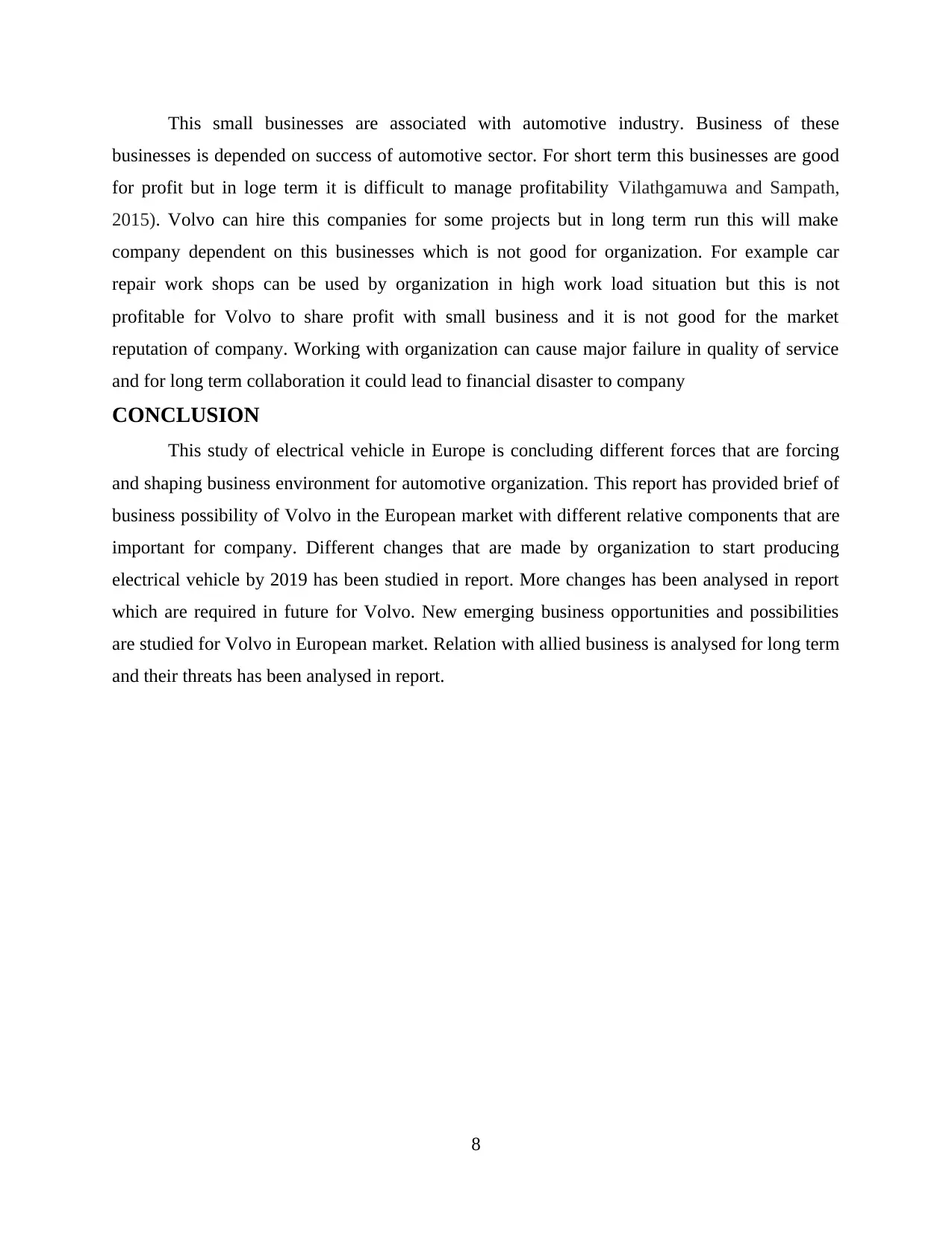
This small businesses are associated with automotive industry. Business of these
businesses is depended on success of automotive sector. For short term this businesses are good
for profit but in loge term it is difficult to manage profitability Vilathgamuwa and Sampath,
2015). Volvo can hire this companies for some projects but in long term run this will make
company dependent on this businesses which is not good for organization. For example car
repair work shops can be used by organization in high work load situation but this is not
profitable for Volvo to share profit with small business and it is not good for the market
reputation of company. Working with organization can cause major failure in quality of service
and for long term collaboration it could lead to financial disaster to company
CONCLUSION
This study of electrical vehicle in Europe is concluding different forces that are forcing
and shaping business environment for automotive organization. This report has provided brief of
business possibility of Volvo in the European market with different relative components that are
important for company. Different changes that are made by organization to start producing
electrical vehicle by 2019 has been studied in report. More changes has been analysed in report
which are required in future for Volvo. New emerging business opportunities and possibilities
are studied for Volvo in European market. Relation with allied business is analysed for long term
and their threats has been analysed in report.
8
businesses is depended on success of automotive sector. For short term this businesses are good
for profit but in loge term it is difficult to manage profitability Vilathgamuwa and Sampath,
2015). Volvo can hire this companies for some projects but in long term run this will make
company dependent on this businesses which is not good for organization. For example car
repair work shops can be used by organization in high work load situation but this is not
profitable for Volvo to share profit with small business and it is not good for the market
reputation of company. Working with organization can cause major failure in quality of service
and for long term collaboration it could lead to financial disaster to company
CONCLUSION
This study of electrical vehicle in Europe is concluding different forces that are forcing
and shaping business environment for automotive organization. This report has provided brief of
business possibility of Volvo in the European market with different relative components that are
important for company. Different changes that are made by organization to start producing
electrical vehicle by 2019 has been studied in report. More changes has been analysed in report
which are required in future for Volvo. New emerging business opportunities and possibilities
are studied for Volvo in European market. Relation with allied business is analysed for long term
and their threats has been analysed in report.
8
Paraphrase This Document
Need a fresh take? Get an instant paraphrase of this document with our AI Paraphraser
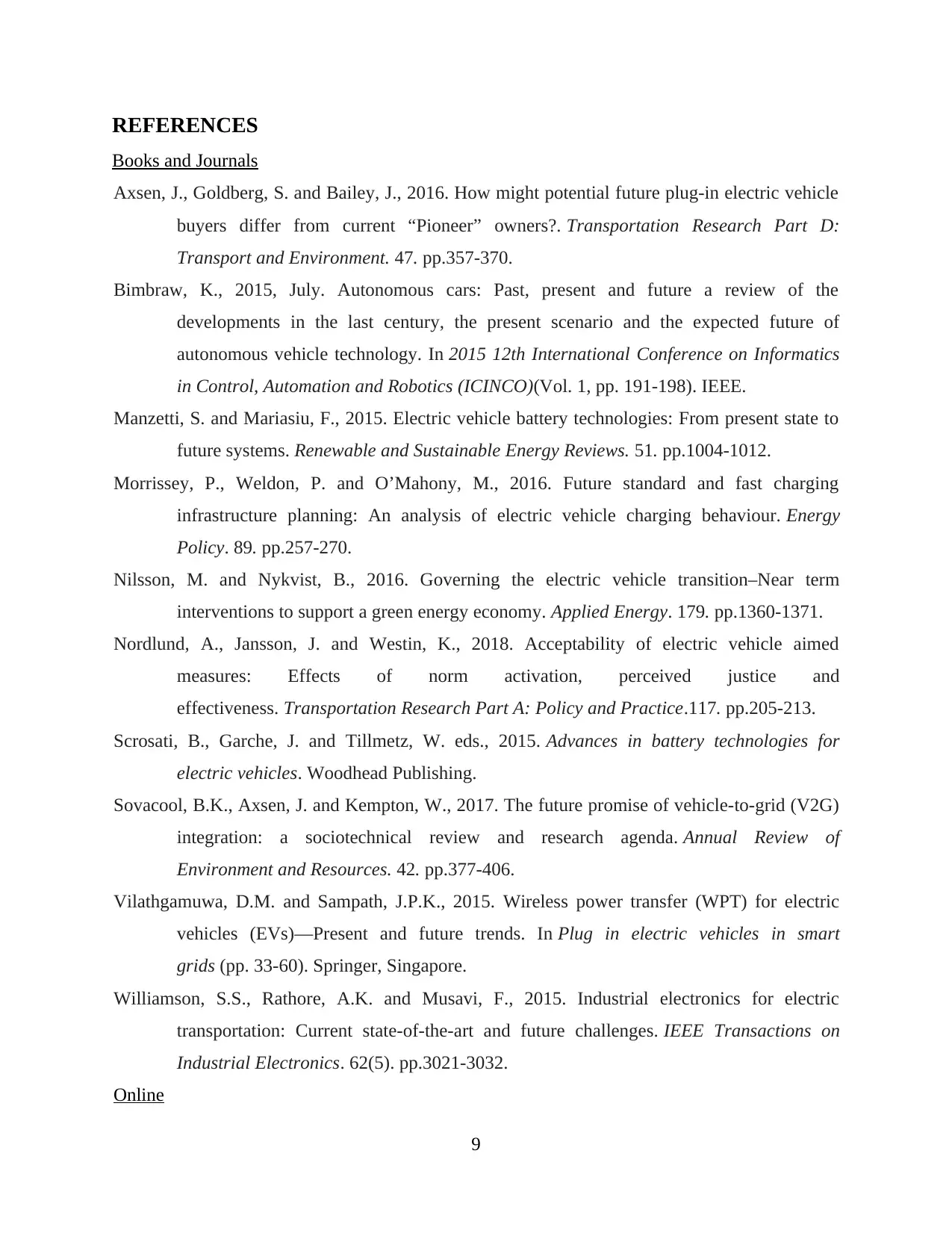
REFERENCES
Books and Journals
Axsen, J., Goldberg, S. and Bailey, J., 2016. How might potential future plug-in electric vehicle
buyers differ from current “Pioneer” owners?. Transportation Research Part D:
Transport and Environment. 47. pp.357-370.
Bimbraw, K., 2015, July. Autonomous cars: Past, present and future a review of the
developments in the last century, the present scenario and the expected future of
autonomous vehicle technology. In 2015 12th International Conference on Informatics
in Control, Automation and Robotics (ICINCO)(Vol. 1, pp. 191-198). IEEE.
Manzetti, S. and Mariasiu, F., 2015. Electric vehicle battery technologies: From present state to
future systems. Renewable and Sustainable Energy Reviews. 51. pp.1004-1012.
Morrissey, P., Weldon, P. and O’Mahony, M., 2016. Future standard and fast charging
infrastructure planning: An analysis of electric vehicle charging behaviour. Energy
Policy. 89. pp.257-270.
Nilsson, M. and Nykvist, B., 2016. Governing the electric vehicle transition–Near term
interventions to support a green energy economy. Applied Energy. 179. pp.1360-1371.
Nordlund, A., Jansson, J. and Westin, K., 2018. Acceptability of electric vehicle aimed
measures: Effects of norm activation, perceived justice and
effectiveness. Transportation Research Part A: Policy and Practice.117. pp.205-213.
Scrosati, B., Garche, J. and Tillmetz, W. eds., 2015. Advances in battery technologies for
electric vehicles. Woodhead Publishing.
Sovacool, B.K., Axsen, J. and Kempton, W., 2017. The future promise of vehicle-to-grid (V2G)
integration: a sociotechnical review and research agenda. Annual Review of
Environment and Resources. 42. pp.377-406.
Vilathgamuwa, D.M. and Sampath, J.P.K., 2015. Wireless power transfer (WPT) for electric
vehicles (EVs)—Present and future trends. In Plug in electric vehicles in smart
grids (pp. 33-60). Springer, Singapore.
Williamson, S.S., Rathore, A.K. and Musavi, F., 2015. Industrial electronics for electric
transportation: Current state-of-the-art and future challenges. IEEE Transactions on
Industrial Electronics. 62(5). pp.3021-3032.
Online
9
Books and Journals
Axsen, J., Goldberg, S. and Bailey, J., 2016. How might potential future plug-in electric vehicle
buyers differ from current “Pioneer” owners?. Transportation Research Part D:
Transport and Environment. 47. pp.357-370.
Bimbraw, K., 2015, July. Autonomous cars: Past, present and future a review of the
developments in the last century, the present scenario and the expected future of
autonomous vehicle technology. In 2015 12th International Conference on Informatics
in Control, Automation and Robotics (ICINCO)(Vol. 1, pp. 191-198). IEEE.
Manzetti, S. and Mariasiu, F., 2015. Electric vehicle battery technologies: From present state to
future systems. Renewable and Sustainable Energy Reviews. 51. pp.1004-1012.
Morrissey, P., Weldon, P. and O’Mahony, M., 2016. Future standard and fast charging
infrastructure planning: An analysis of electric vehicle charging behaviour. Energy
Policy. 89. pp.257-270.
Nilsson, M. and Nykvist, B., 2016. Governing the electric vehicle transition–Near term
interventions to support a green energy economy. Applied Energy. 179. pp.1360-1371.
Nordlund, A., Jansson, J. and Westin, K., 2018. Acceptability of electric vehicle aimed
measures: Effects of norm activation, perceived justice and
effectiveness. Transportation Research Part A: Policy and Practice.117. pp.205-213.
Scrosati, B., Garche, J. and Tillmetz, W. eds., 2015. Advances in battery technologies for
electric vehicles. Woodhead Publishing.
Sovacool, B.K., Axsen, J. and Kempton, W., 2017. The future promise of vehicle-to-grid (V2G)
integration: a sociotechnical review and research agenda. Annual Review of
Environment and Resources. 42. pp.377-406.
Vilathgamuwa, D.M. and Sampath, J.P.K., 2015. Wireless power transfer (WPT) for electric
vehicles (EVs)—Present and future trends. In Plug in electric vehicles in smart
grids (pp. 33-60). Springer, Singapore.
Williamson, S.S., Rathore, A.K. and Musavi, F., 2015. Industrial electronics for electric
transportation: Current state-of-the-art and future challenges. IEEE Transactions on
Industrial Electronics. 62(5). pp.3021-3032.
Online
9

Porter's Five Forces. 2013. [Online]. Available
Through.<https://www.strategicmanagementinsight.com/tools/porters-five-
forces.html>.
10
Through.<https://www.strategicmanagementinsight.com/tools/porters-five-
forces.html>.
10
⊘ This is a preview!⊘
Do you want full access?
Subscribe today to unlock all pages.

Trusted by 1+ million students worldwide
1 out of 12
Related Documents
Your All-in-One AI-Powered Toolkit for Academic Success.
+13062052269
info@desklib.com
Available 24*7 on WhatsApp / Email
![[object Object]](/_next/static/media/star-bottom.7253800d.svg)
Unlock your academic potential
Copyright © 2020–2025 A2Z Services. All Rights Reserved. Developed and managed by ZUCOL.





